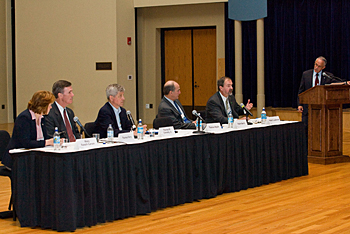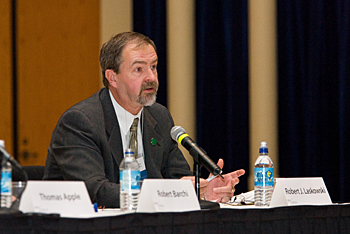
6:30 p.m., May 11, 2008--Forging stronger partnerships between hospitals and academia to advance workforce training and collaborative research will be a major key to the delivery of quality health care in the future, according to the UD Forum panel “Beyond Science: The Future of Health Care, America, and the Life Sciences at UD.”
With heart disease the number-one killer of Delawareans (and Americans nationwide), the University of Delaware should consider enhancing or developing new collaborations in cardiovascular biology, as well as cancer biology, the neurosciences, health policy and population studies, and providing professional education to physicians in such areas as the business aspects of health care, the panel recommended.
Moderated by Thomas Apple, dean of UD's College of Arts and Sciences, the panel included Robert Barchi, president of Thomas Jefferson University; Thomas M. Connelly, executive vice president and chief innovation officer of the DuPont Co.; Mary C. Farach-Carson, professor of biological sciences at UD and director of the Center for Translational Cancer Research; Thomas Ferry, senior vice president and chief executive officer of A. I. du Pont Children's Hospital; and Robert Laskowski, president and chief executive officer of Christiana Care Health System.
Barchi noted that defining the future of health care requires a look back at how physicians and other health-care providers were educated in the past.
In the 1940s, the typical physician was male, went to medical school for four years, and possibly interned for a year, with residency a rarity.
“In the last 40 years, there's been an incredible explosion of information in the sciences,” Barchi noted.
As a result, today's physicians are spending seven to eight years in post-college education. Nurses increasingly are earning the master's degree and doctorate. The same is true of physical therapy.
“We're pushing more education down to colleges,” Barchi said. “We need to be more and more closely aligned with higher education.”
Barchi also noted that today's physicians need to learn more about the business side of health care.
“You have a president at the University of Delaware who's virtually defined business education,” Barchi said. “There is a huge opportunity and need for 'out of the box' delivery of education and huge opportunities to work together.”
When he started as a young faculty member in the 1970s, Barchi said science was done in a scientist's lab with his or her team.
“Now you can't do high-quality science without collaborations,” he noted. “It requires collaborations across institutions, the region and, frankly, the world.”
Farach-Carson, director of the Center for Translational Cancer Research, a collaboration of UD, Christiana Care Health System, A. I. du Pont Hospital for Children and UD's Delaware Biotechnology Institute, talked about the importance of partnerships in expanding access to research and resources.
She noted how a UD undergrad working on family pedigrees in the cancer registry at Christiana Care's Helen F. Graham Cancer Center noticed an intriguing breast cancer mutation. Now a graduate student, he is doing breast cancer research with clinicians at the center.
“Getting them in the lab makes all the difference in the world,” she said.
Farach-Carson said she attributes the center's success in forming partnerships to a quote by Ronald Reagan: “You can accomplish much if you don't care who gets the credit.”
To forge successful collaborations, you have to keep your focus on the goal, involve diverse team members, learn “the cultures and currencies of each other” in order to bring together interdisciplinary groups, and “support the doers and not the talkers,” Farach-Carson noted.“In building these interdisciplinary efforts, the biggest challenge is improving communication,” Farach-Carson said. “We need to create ways to increase communication, improve communication.”
When asked about the hurdles to partnerships, Ferry said, “They're not really hurdles. You have to find the time....It's having the will to be intentional about accomplishing the synergy we're looking for.”
Ferry noted that when A. I. du Pont Hospital for Children opened in 1940, its focus was on pediatric orthopedics. In the 1980s, the hospital expanded to full-service pediatrics.
Today, the hospital maintains strong ties to Thomas Jefferson University's Medical College and has collaborations with UD in biomechanics, linguistics and the Center for Translational Cancer Research.
“Really successful collaboration requires constant contact,” according to Connelly of DuPont.
In 2001, DuPont established an alliance with MIT for research in the applied biosciences. While in the initial stages of the program, the researchers tended to operate in separate camps with limited collaboration, that quickly “melted away,” Connelly said, and now all proposals in the program are jointly proposed by DuPont and MIT researchers.
Research increasingly is becoming globalized, Connelly said. DuPont opened major research centers in China and India in the past two years. He also referenced the National Academy of Sciences' report Rising Above the Gathering Storm and the critical need in the United States to attract “the best and brightest from our shores” to science and engineering.
Laskowski, of Christiana Care, which serves a region of some 1.2 million people, said the medical system's commitment to providing “care with excellence” relates directly to their partnerships with Thomas Jefferson University, UD and the business community.
Thanks to collaborations with Farach-Carson and the Center for Translational Cancer Research, Laskowski noted, the medical staff “are actively and intellectually engaged in providing much better care. It makes a very substantial difference in the care that we provide,” he said.
Laskowski also pointed out that in examining Delaware's demographics, “We look like the United States. What a wonderful place to test out new ideas,” he said. “It's a great place to do population-based work.”
In identifying areas ripe for research collaboration, Laskowski reminded the audience that the No. 1 killer of Delawareans is heart disease.
“That's a very fertile area and an important one for our community,” he said.
Article by Tracey Bryant
Photos by Kevin Quinlan



